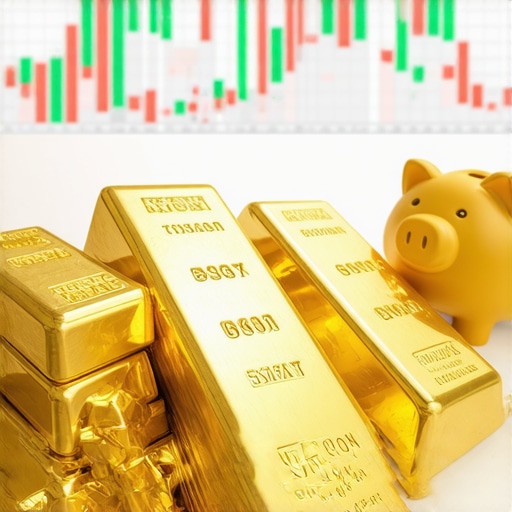Understanding the Benefits of Gold ETFs for Diversification
Investing in gold has long been recognized as a stable and reliable strategy for diversifying an investment portfolio. Among the various options available, Gold Exchange-Traded Funds (ETFs) have emerged as a popular choice for investors seeking to capitalize on gold’s value while minimizing risks. Gold ETFs enable investors to gain exposure to gold prices without the need to physically own the metal, making them an accessible option for those new to gold investments.
What Are Gold ETFs and How Do They Work?
Gold ETFs are investment funds that trade on stock exchanges, aiming to track the price of gold. They provide a simple way to invest in gold without purchasing physical gold bars or coins. When you buy shares of a gold ETF, you are essentially buying a share of a fund that holds gold assets, which can be gold bullion or gold-related securities.
One of the significant advantages of gold ETFs is their liquidity, allowing investors to buy and sell shares throughout the trading day at market prices, similar to stocks. This flexibility makes gold ETFs an attractive option for both short-term traders and long-term investors.
Why Consider Diversifying with Gold ETFs?
Diversification is a key principle of investing, helping to spread risk across different asset classes. By including gold ETFs in your investment strategy, you can hedge against market volatility. Historically, gold has maintained its value during economic downturns, serving as a safe haven for investors.
According to a report by the World Gold Council, gold can play a crucial role in an investment portfolio by reducing overall risk and enhancing returns. This is particularly important during uncertain economic times when traditional assets may falter.
How Do Gold ETFs Compare to Other Gold Investments?
While gold ETFs offer a convenient way to invest in gold, they are not the only option available. Physical gold, such as coins and bars, provides tangible ownership but comes with storage and insurance costs. On the other hand, gold ETFs typically have lower fees and can be bought or sold easily through brokerage accounts.
Investors should weigh the pros and cons of each gold investment type. For those who prefer simplicity and lower costs, gold ETFs are an excellent choice. However, for individuals who value physical ownership, investing in gold coins or bars might be more appealing.
Conclusion: Make a Smart Move with Gold ETFs
Incorporating gold ETFs into your investment strategy can be a smart move, providing diversification and a hedge against economic uncertainty. As you explore your investment options, consider the advantages of gold ETFs and how they can fit into your broader financial goals. To learn more about effective gold investment strategies, check out our post on gold investment strategies for 2025.
Have you considered including gold ETFs in your portfolio? Share your thoughts below!
The Role of Gold ETFs in a Diversified Investment Portfolio
Gold ETFs play a significant role in a diversified investment portfolio, enabling investors to manage risk while seeking growth. These funds not only provide exposure to gold prices but also serve as a buffer against economic fluctuations. By integrating gold ETFs into your strategy, you can benefit from gold’s historical performance, particularly during economic instability.
How Can Gold ETFs Help Manage Investment Risk?
Investors often seek to understand how gold ETFs can mitigate risk in their portfolios. Gold has historically acted as a safe haven asset, maintaining its value during market downturns. A study by the World Gold Council reveals that including gold in an investment portfolio can reduce volatility and enhance overall returns. When the stock market dips, gold often retains its value or even appreciates, providing a cushion against losses.
This characteristic is particularly appealing to conservative investors who prioritize capital preservation. Furthermore, gold ETFs typically have lower management fees compared to actively managed funds, adding an additional layer of appeal for budget-conscious investors.
Comparing Gold ETFs to Traditional Gold Investments
When considering gold investments, it’s essential to compare gold ETFs with traditional forms of gold ownership, such as physical gold bars and coins. While physical gold offers the advantage of tangible assets, it also comes with challenges like storage, security, and insurance costs.
Gold ETFs, on the other hand, eliminate these logistical concerns. They provide an efficient way to gain exposure to gold without the need for physical storage. Investors can easily buy and sell shares of gold ETFs on stock exchanges, which enhances liquidity. This ease of trading is a compelling reason why many investors prefer gold ETFs over traditional forms of gold investment.
What Are the Key Benefits of Investing in Gold ETFs?
The benefits of investing in gold ETFs are numerous. First, they offer diversification, allowing investors to spread risk across various asset classes. Second, the low expense ratio associated with gold ETFs makes them a cost-effective investment option. Third, gold ETFs are accessible to a wide range of investors, from beginners to seasoned professionals.
Moreover, gold ETFs can be easily integrated into retirement accounts, making them a suitable option for long-term investors. According to Wikipedia, ETFs have revolutionized investing by making it easier for individuals to access a diverse range of assets, including gold.
Investing in Gold ETFs: A Strategic Move for 2025
As we approach 2025, the economic landscape remains uncertain, making gold ETFs an attractive choice for investors looking to safeguard their financial future. The rising inflation rates and geopolitical tensions can lead to increased demand for gold, thus driving up its price. Investing in gold ETFs now may be a strategic move to leverage potential price increases in the near future.
Have you considered diversifying your investment portfolio with gold ETFs? Share your thoughts and experiences in the comments below, and if you’re looking for more insights on effective gold investment strategies, check out our post on gold investment strategies for 2025.
The Future of Gold ETFs: Trends to Watch in 2025
As we look ahead to 2025, understanding the trends shaping the gold market is crucial for making informed investment decisions. Gold ETFs are expected to continue gaining traction as investors seek stability amidst economic uncertainty. With rising inflation and fluctuating interest rates, gold’s historical role as a safe haven asset becomes increasingly significant.
According to World Gold Council, gold ETFs saw a surge in demand during periods of economic instability, making them a valuable component of a diversified portfolio. Investors are likely to turn to gold ETFs not just for potential price appreciation but also for their ability to hedge against inflation and economic downturns.
How Do Gold ETFs Fit into a Long-Term Investment Strategy?
Integrating gold ETFs into a long-term investment strategy can provide a balanced approach to wealth management. By allocating a portion of your portfolio to gold, you can mitigate risks associated with market volatility. This can be particularly beneficial for retirement planning, where preserving capital is paramount.
People Also Ask: What Factors Should Investors Consider When Choosing Gold ETFs?
When selecting gold ETFs, investors should consider several key factors:
- Expense Ratios: Lower expense ratios can enhance your long-term returns. Compare different gold ETFs to find those with competitive fees.
- Liquidity: Choose ETFs that trade on major exchanges with high liquidity to ensure you can enter and exit positions without significant price impact.
- Underlying Assets: Investigate what assets the ETF holds. Some may invest directly in physical gold, while others may include gold mining stocks.
Understanding these factors can help investors make choices that align with their financial goals.
The Importance of Staying Informed About Gold Market Trends
Keeping abreast of gold market trends is essential for any investor. Factors such as geopolitical instability, central bank policies, and global economic conditions can significantly influence gold prices. By staying informed, you can make timely decisions that capitalize on market opportunities.
Engaging with reputable financial news sources and analysis reports can provide valuable insights into the gold market. Additionally, monitoring economic indicators such as inflation rates and currency fluctuations can enhance your investment strategy.
Conclusion: Take Action to Secure Your Financial Future
As you consider your investment options, gold ETFs stand out as a compelling choice for diversification and risk management. By understanding the benefits, trends, and strategies associated with gold ETFs, you can position yourself for success in the ever-changing financial landscape. Don’t hesitate to explore our related articles for more insights on effective gold investment strategies. If you have any experiences or questions about gold ETFs, feel free to share them in the comments below!
Understanding Market Trends Impacting Gold ETFs in 2025
As we navigate through 2025, it is essential to comprehend the market dynamics that influence gold ETFs. Factors such as inflation, interest rates, and geopolitical events play a significant role in shaping investor behavior and gold prices. These variables can directly affect the performance of gold ETFs, making it crucial for investors to stay informed about current trends.
For instance, rising inflation can lead to increased demand for gold, as investors typically seek assets that preserve value. According to Investopedia, inflation often drives investors towards gold as a protective measure against currency devaluation. Conversely, high-interest rates can dampen gold’s appeal, as they increase the opportunity cost of holding non-yielding assets like gold. Understanding these trends can help investors time their investments more effectively.
Integrating Gold ETFs into Your Investment Portfolio
Integrating gold ETFs into your overall investment strategy is not just about diversification; it’s about enhancing your portfolio’s resilience against market fluctuations. A balanced approach may involve allocating a specific percentage of your portfolio to gold ETFs, which can act as a hedge during economic downturns.
How Can Investors Optimize Their Gold ETF Holdings?
Investors looking to optimize their gold ETF holdings should consider the following strategies:
- Regular Portfolio Rebalancing: Periodically review and adjust your gold ETF allocation based on market conditions and your financial goals. This ensures that your portfolio remains aligned with your investment objectives.
- Cost Analysis: Keep an eye on the expense ratios of your gold ETFs. Lower fees can enhance your long-term returns, making it essential to compare different options regularly.
- Market Timing: While timing the market can be risky, being aware of macroeconomic indicators can guide you in making more informed decisions about when to buy or sell gold ETFs.
By implementing these strategies, investors can maximize their gains while reducing risks associated with market volatility.
The Future of Gold ETFs: What to Expect
The future of gold ETFs looks promising as more investors recognize the importance of gold in their portfolios. With global uncertainties continuing to drive demand for safe-haven assets, gold ETFs are likely to remain a popular choice. Additionally, advancements in technology and trading platforms have made investing in gold ETFs more accessible, attracting a new generation of investors.
As we move forward, it is essential to keep an eye on regulatory changes and market developments that could impact gold ETFs. By staying informed and adaptable, investors can position themselves to capitalize on future opportunities.
Conclusion: Take Action to Enhance Your Investment Strategy
Incorporating gold ETFs into your investment portfolio is a strategic move that can enhance your overall financial health. By understanding market trends, optimizing your holdings, and staying informed, you can make well-timed investment decisions that align with your long-term goals. If you’re eager to learn more about effective gold investment strategies, be sure to check out our detailed guide on gold investment strategies for 2025. Share your thoughts or questions about gold ETFs in the comments below, and let’s discuss how to make the most of this valuable asset!
Frequently Asked Questions (FAQ)
What are the advantages of investing in Gold ETFs compared to physical gold?
Gold ETFs offer several advantages over physical gold. They provide liquidity, allowing investors to buy and sell easily on stock exchanges. Additionally, Gold ETFs usually have lower management fees and eliminate storage and security concerns associated with physical gold ownership.
How do Gold ETFs perform during economic downturns?
Historically, Gold ETFs have performed well during economic downturns, as gold is considered a safe haven asset. Investors often flock to gold in times of uncertainty, which can lead to an increase in ETF value as demand rises.
Can I hold Gold ETFs in my retirement account?
Yes, many retirement accounts, including IRAs and 401(k)s, allow for the inclusion of Gold ETFs. This can provide a hedge against inflation and market volatility within your retirement portfolio.
Are Gold ETFs suitable for beginners?
Absolutely! Gold ETFs are suitable for beginners as they are easy to understand and trade. They offer a straightforward way to gain exposure to gold without the complexities of managing physical assets.
How do I choose the right Gold ETF for my investment needs?
When selecting a Gold ETF, consider factors such as the fund’s expense ratio, liquidity, and the underlying assets it holds. Look for ETFs that trade on major exchanges and have a reputable management team.
What is the typical expense ratio for Gold ETFs?
The expense ratio for Gold ETFs can vary, but it typically ranges from 0.25% to 0.75%. Lower expense ratios are preferable, as they can enhance your long-term returns.
Do Gold ETFs pay dividends?
Generally, Gold ETFs do not pay dividends because they track the price of gold rather than generating income through investments in stocks or bonds. However, some funds may pay occasional distributions based on fund performance.
How can I monitor the performance of my Gold ETF investments?
Investors can monitor the performance of Gold ETFs through stock market platforms, financial news websites, or by using investment apps. Tracking gold prices and market trends is also beneficial for understanding the overall performance of your ETF.
What should I know about taxes on Gold ETF investments?
Gold ETFs are subject to capital gains taxes when sold for a profit, similar to stocks. It’s essential to consult with a tax advisor to understand your tax obligations related to gold investments.
What are some risks associated with investing in Gold ETFs?
While Gold ETFs have advantages, they also come with risks. These include market volatility, management fees, and potential tracking errors where the ETF may not perfectly track the price of gold. Understanding these risks is crucial for informed investing.
Authoritative Sources
World Gold Council: This organization provides in-depth research and statistics on gold demand and investment trends, making it a key resource for understanding the gold market.
Investopedia: A trusted financial education platform that offers guides and articles on investing, including comprehensive insights on Gold ETFs and other investment vehicles.
Wikipedia: The entry on exchange-traded funds provides a broad overview of ETFs, including types and functions, helping investors understand their basic principles.
Morningstar: Renowned for its investment research, Morningstar offers analysis and ratings of various ETFs, including those focused on gold, assisting investors in making informed choices.
Bloomberg: A leading financial news provider that covers market trends, including gold prices and economic factors influencing the gold market, offering timely insights for investors.
Conclusion: Take Action to Enhance Your Investment Strategy
Incorporating Gold ETFs into your investment portfolio is a strategic move that can enhance your overall financial health. By understanding market trends, optimizing your holdings, and staying informed, you can make well-timed investment decisions that align with your long-term goals. Gold ETFs not only provide diversification but also act as a hedge against economic uncertainty. If you’re eager to learn more about effective gold investment strategies, be sure to check out our detailed guide on gold investment strategies for 2025. Share your thoughts or questions about Gold ETFs in the comments below, and let’s discuss how to make the most of this valuable asset!









